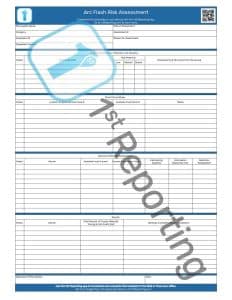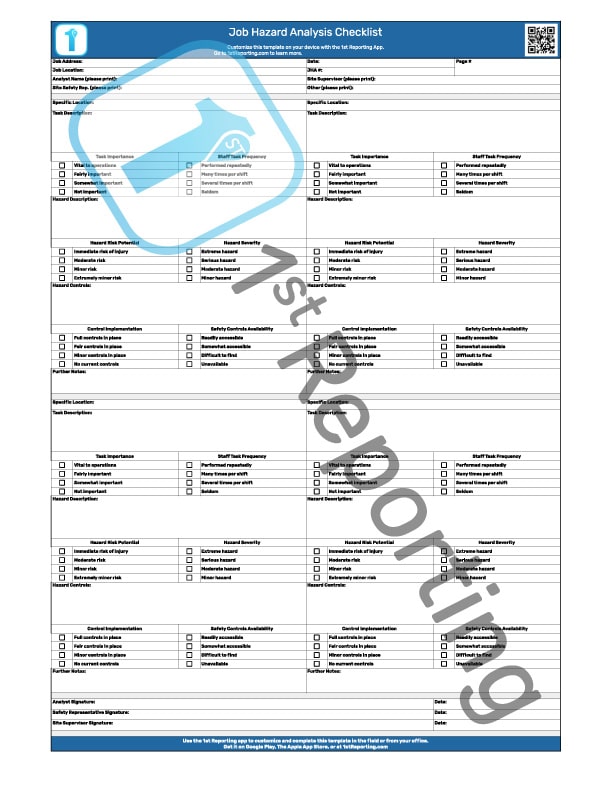An arc flash risk assessment is crucial to maintaining electrical safety. Just imagine a situation where a loose connection costs someone their life when it explodes violently inside your building. An explosion of the sun’s surface heat isn’t something to mess around with. It’s the reality of arc flash incidents, which is why managers must understand the significance of conducting regular arc flash assessments.
An Arc Flash Risk Assessment Template is a document for recording observations during an arc flash risk assessment. These audits provide insight into the potential for an arc flash and allow companies the opportunity to correct inadequacies before they become severe or even life-threatening incidents.
We’ve created a complimentary Arc Flash Risk Assessment that your qualified personnel can use to document their arc flash risk audits. Furthermore, this guide can help aid your training of said personnel, so don’t be afraid to bookmark this page for future reference. Let’s get started with what we’ve included in the document (also available on our mobile-form app, 1st Reporting).
Included In The Arc Flash Risk Assessment Template

The Arc Flash Risk Assessment Template comprises five primary sections:
- Administrative Information
- Hazard Identification, Potential, and Severity
- Short Circuit Study
- Device and Breaker Assessment
- Results
We’ll detail how to use each section and the document in the next section. Let’s take a quick look at each section in a little more detail.
Administrative Information
The administrative section is critical to document management. In the top portion of the document, your inspector/auditor will print their name, the company (is using the form as a third-party, then record your client’s company name here), the equipment identifier and location, date reason of assessment, and assessment number.
This vital information lets you get a brief look at what, where, when, and why the assessment took place. It enables you to maintain a semblance of order when filing reports. Of course, you won’t have to worry about filing reports, filing cabinets, or even paper if you use our app version of the template. It enables your auditors to use it on their smartphone, tablet, or other devices. We’ll talk more about that later.
Hazard Identification, Potential, and Severity
The initial part of the assessment clarifies some of the hazards, the potential for occurrence, and the event’s severity. Although this section is first, there is potential to complete it as the assessment provides further information about the risk potential.
Short Circuit Study
The short circuit study is crucial in determining the potential for a severe arc flash event. The qualified auditor will record the location and note the available fault current at that point of the circuit. This information is critical in calculating the further assessment to follow. We’ve also provided an area where the auditor might make a few notes regarding each location of potential electrical fault.
Device and Breaker Assessment
Once the short circuit study provides fault current information, circuit devices require further assessment. In the device and breaker assessment, various points (devices) within the circuit face analysis, and the current interruption types, capacities, and operation time needs documentation. Further to this documentation, we’ve included a final acceptable operation note column where your auditor can note individual device or circuit point test/calculation results.
Results
Speaking of results, the final analysis of the arc flash potential includes understanding the total amount of energy released by an arc flash event at any point in the circuit/device. The audit can record this information in the results section and final recommendations for circuit/equipment interruption settings. Furthermore, the auditor may have specific recommendations for required safety equipment to service the equipment or circuit.
How To Use The Arc Flash Risk Assessment Template

The first rule of arc flash risk assessment is to ensure that two things are crystal clear to all who work near arc flash potential.
- No unauthorized personnel should work on or near equipment with arc flash potential.
- No unauthorized personnel should perform an arc flash risk assessment.
These two rules come down to a straightforward concept: training. We strongly recommend that only appropriately trained personnel use arc flash equipment or perform an arc flash assessment.
Assuming that you are following the above rules, here’s how to proceed:
- Download our Arc Flash Risk Assessment checklist (template) or use the digital version in our app, 1st Reporting.
- Disperse the template to your appropriately trained and authorized personnel.
- Schedule regular arc flash risk assessments, arc flash risk assessment training, and refresher training.
- Ensure all personnel who perform the assessment understand how to complete the document.
That’s it, in a nutshell, just four easy steps to using the arc flash risk assessment template. However, performing the risk assessment itself is much more complicated. That’s why only adequately trained and qualified personnel should complete the evaluation.
Tips For Planning More Efficient Safety Audits

Arc flash risk assessments are only one of the many you’re likely to encounter. There are many more, from job hazard analysis to site condition audits to a seemingly endless list of others. Suppose we include incident documentation in an inspection or audit documentation. In that case, I’m sure we’re talking more than you or I would care to count.
How can we manage many different audits, incidents, inspections, or other events where our teams must record observations? We’ve strived to answer these and other questions, so much so that we’ve got some great actionable advice for you.
Assessment Key Considerations
There are several considerations for assessing arc flash potential. Let’s look at how we can effectively work out a plan of action for arc flash assessments.
- Is the equipment power source greater than 50v? The established maximum is 50v before arc flash becomes a severe concern. Not to say that a 49v circuit is safe, but the specified maximum gives some reasonable assurance that it is not a candidate for extreme arc-flash potential.
- Does your region comply with NFPA 70E? Further to our first point above, every circuit has a minimum safe working distance. That is a distance from where an arc hazard exists to a point deemed acceptable by the NFPA. This distance is known as the limited approach boundary. For any energized circuit with a voltage greater than 50v, where a worker may enter within the limited approach boundary, the equipment must be de-energized before entering the limited approach distance.
- NFPA 70 also stipulates that proper de-energizing is a requirement even when the circuit where arc flash potential exists has a cover. So, suppose you’ve got a high-voltage electrical breaker panel. In that case, workers shouldn’t enter within the limited approach distance, despite the panels having a cover. Arc flash explosions can blow the cover off, so we cannot ignore the minimum safe approach distance.
- Is the equipment properly labeled? Older panels and other electrical equipment may not have appropriate labels. An arc flash assessment is a bright idea whenever you have equipment that is over 50v and lacks appropriate warning labels. Furthermore, it’s also apparent that installing the proper equipment warning labels is a bright idea.
- Does the equipment have more than one power source? I’ve worked on equipment with multiple phases of power, and I’ve worked on equipment with both a high and ‘low’ voltage circuit, with their exclusive power sources. It isn’t uncommon for motor controllers and other devices to have multiple power sources. Again, suppose labels don’t effectively communicate potential dangers. In that case, an arc flash assessment followed by proper labeling and other safety precautions is a definite must.
Efficient Safety Audit Documentation
One of the reasons many companies, or rather, many people, choose to skip parts of or even complete safety inspections is the toll it takes on their operations. A proper safety inspection will often force specific equipment to shut down for a time. Indeed, we want to ensure that safety doesn’t affect operations and vice versa. However, we need to achieve a balance between safety and operational effectiveness.
One of the best ways to effectively counter the safety inspections’ adverse effects on operations is by ensuring that you empower your inspectors with the right tools to complete their assessments efficiently.
Provided the appropriate tools, most professionals will get their inspections done in a reasonable amount of time compared to those who struggle with inappropriate tools for their work. We want inspections to go smoothly. Still, we also don’t want our teams to miss anything critical, that’s for sure.
One of the best ways organizations can effectively mitigate slow and tedious inspections are by using a digital inspection documentation platform. In short, a mobile app like 1st Reporting lets them complete assessments on their smart device. Similarly, the smart device can act as the inspection document medium whether within range of an internet signal or not. It empowers your teams to work anywhere with its powerful offline mode. It simply stores the data locally on the device until a signal acquisition occurs.
The 1st Reporting app revolutionizes how businesses and organizations capture risk assessment data (like arc flash potential information). Still, it’s also cheaper than you’d think. For such a robust platform, the pricing page says it all – This tool helps your team work more efficiently, and the price is efficient too.
Please don’t take our word for it or even our clients’ many great reviews and testimonials. No, it would be best if you considered trying it for yourself. And if you aren’t sure how to implement it, just request a demo from our team, and we’ll walk you through how to get started.




